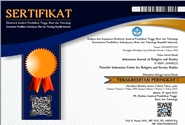Evaluation of Rashd Al-Qiblah Method Accuracy: Spherical Plane And Ellipsoid Approaches in Qibla Direction Determination
Abstract
Determination of Qibla direction is an important aspect in the implementation of Muslim worship. One of the methods used is rashd al-qiblah, which is a direct observation based on the shadow of an object when the sun is directly above the Kaaba. However, the use of rashd al-qiblah that considers the shape of the Earth's ellipsoid through Vincenty Theory is still very limited. This study aims to analyze the accuracy of determining the Qibla direction using two geometric approaches, namely the spherical plane and the ellipsoid, and compare it with the results of direct observation using the rashd al-qiblah method. The research location is focused on Banjarmasin, which is geographically qualified to use the rashd al-qiblah method. The results of this study are expected to provide a comprehensive picture of the differences in accuracy between the two calculation methods and the direct observation method. The analysis also aims to evaluate the reliability of the ellipsoid-based method in the context of Qibla direction determination practice. The findings of this study can be an important reference for phalacticians and the general public in choosing the most accurate method for Qibla direction determinatio
Keywords
Full Text:
PDFReferences
Anugraha, R. (2012). Mekanika Benda Langit. Yogyakarta: Jurusan Fisika Fakultas MIPA Universitas Gajah Mada.
Awalluddin, M. & others. (2018). Analisis Setting Out Arah Kiblat dengan GPS Real Time Kinematic. Jurnal Elipsoida, 1(1).
Azhari, S. (2001). Ilmu Falak: Teori dan Praktek. Yogyakarta: Lazuardi.
Azhari, S. (2007). Ilmu falak: Perjumpaan khazanah Islam dan sains modern. Suara Muhammadiyah.
Committee, D. W. 84 D. (1991). Departement of Defense World Geodetic System 1984 (Second Edition). Defense Mapping Agency.
Faid, M. S., Nahwandi, M. S., Nawawi, M. S. A. B. M., Zaki, N. B. A., & Saadon, M. H. M. (2022). Development of Qibla Direction Determinant Using Sun Shadow. Online Journal of Research in Islamic Studies, 9(1), 89–102.
Helmi, R. & Badrian. (2019). Akurasi Arah Kiblat Masjid-Masjid di Kabupaten Banjar. Banjarmasin: Antasari Press.
Hosen, H., & Ghafiruddin, G. (2018). Akurasi Arah Kiblat Masjid di Wilayah Kecamatan Pademawu Kabupaten Pamekasan dengan Metode Mizwala Qibla Finder. AL-IHKAM: Jurnal Hukum & …, (Query date: 2024-04-12 15:50:16). Retrieved from https://ejournal.iainmadura.ac.id/alihkam/article/view/1837
Khafid, I. (2013). Telaah Pedoman Buku Hisab Arah Kiblat. Cibinong: Badan Informasi Geospasial.
Khazin, M. (2004). Ilmu Falak dalam Teori dan Praktik. Yogyakarta: Buana Pustaka.
Mahmud, H., Bahran, B., Ipansyah, N., Faridah, S., & Ruslan, R. (2023). Understanding Qibla Orientation through the “Nagara” Artificial Compass: A Falak Legal Perspective. Syariah: Jurnal Hukum Dan Pemikiran, 23(1), 78–91. https://doi.org/10.18592/sjhp.v22i2.6492
Mashunah & others. (2013). Presisi Kiblat Masjid-Masjid di Kota Banjarmasin. Tashwir, 1(1).
Munfaridah, I. (2022). Analysis of Sun Declination to Deviation Results: Qiblate Directions al-Mujahidin Mosque, Totokan Village, Mlarak District, Ponorogo Regency. Proceeding: International Conference on Islamic Studies (ICIS) IAIN Ponorogo, 186–197. Retrieved from https://prosiding.iainponorogo.ac.id/index.php/icis/article/view/794
Niri, M. A., Zaki, N. A., & Nor, M. L. H. M. (2023). ANALISIS KOMPUTASIONAL APLIKASI SUN COMPASS DALAM PENENTUAN ARAH KIBLAT MUSLIM: Computational Analysis of Sun Compass Application in the Determination of Muslim Qibla Direction. Jurnal Fiqh, 20(1), 1–32.
Putri, Z. S., & Rosyidi, M. (2024). History Development Instruments Measuring The Qibla In Indonesia. Al-Afkar, Journal For Islamic Studies, 7(2), 620–629.
Qulub, S. T. (2013). Analisis Metode Rashd al-Qiblah dalam Teori Astronomi dan Geodesi (Tesis). Program Pascasarjana IAIN Walisongo, Semarang.
Sabiq, F. (2021). Ijtihad in the qibla direction of The Great Mosque of Demak. International Conference on Syariah & Law, 57–72. Retrieved from https://conference.uis.edu.my/iconsyal/images/eprosiding/5009.pdf
Thoyfur, M. (2021). Digitalization of Local Rashdul Qibla by Qibla Diagram. Al-Hilal: Journal of Islamic Astronomy, 3(1), 75–106.
Vincenty, T. (1975a). Direct and Inverse Solution of Geodesics on the Ellipsoid with Application of Nested Equations. Survey Review, XXII(176), 88–90.
Vincenty, T. (1975b). Direct and Inverse Solution of Geodesics on the Ellipsoid with Application of Nested Equations. Survey Review, 22(176).
Wicaksono, S. & others. (2016). Analisis Spasial Arah Kiblat Kota Semarang. Jurnal Geodesi Undip, 5(4).
Yaqin, A. (2022). Contemporary Haqiqī Calculation: Analysis of Rinto Anugraha’s Lunar Eclipse Calculation Methods. Journal of Islamic Law (JIL), (Query date: 2024-04-12 15:13:15). Retrieved from http://e-journal.iainptk.ac.id/index.php/jil/article/view/531
DOI: https://doi.org/10.36256/ijrs.v6i2.491
Refbacks
- There are currently no refbacks.
Copyright (c) 2024 Indonesian Journal of Religion and Society

This work is licensed under a Creative Commons Attribution-NonCommercial 4.0 International License.
Indonesian Journal of Religion and Society (IJRS) Is Indexed By:

Indonesian Journal of Religion and Society (IJRS) is distribute under Creative Commons Attribution-NonCommercial 4.0 International License.













